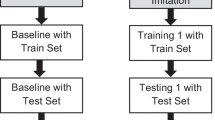Abstract
This study replicated and extended Wright (2006) and Whitehurst, Ironsmith, and Goldfein (1974) by examining whether preschool aged children would increase their use of passive grammatical voice rather than using the more age-appropriate active grammatical construction when the former was modeled by an adult. Results showed that 5 of the 6 participants began using the passive voice after this verbal behavior had been modeled. For 3 of the participants, this change was large. The change occurred even though the adult model explicitly rewarded the participant with praise and stickers for using the active voice, while providing no praise or stickers for using the passive form that was modeled. For 1 participant, the modeling procedure had no effect on use of the passive voice. These results indicate a strong automatic reinforcement effect of achieving parity with the grammatical structures used by adults, compared to the effects of explicit reinforcement by the adult. This might help to explain why children acquire grammatical structures prevalent in their language community apparently without explicit instruction.
Similar content being viewed by others
References
Allen, S. E., & Crago, M. B. (1996). Early passive acquisition in Inuktitut. Journal of Child Language, 23, 129–155.
Berman, R. A. (1985). The acquisition of Hebrew. In D. Slobin (Ed.), The crosslin-guistic study of language acquisition (Vol. 1, pp. 255–371). Hillsdale, NJ: Erlbaum.
Brown, R., & Hanion, C. (1970). Derivational complexity and order of acquisition in child speech. In J. R. Hayes (Ed.), Cognition and the development of language (pp. 11–53). New York: Wiley.
Catania, A. C. (2007). Learning (4th ed.). New York: Sloan Publishing.
Chomsky, N. (1980). Rules and representations. New York: Columbia University Press.
Demuth, K. (1989). Maturation and the acquisition of the Sesotho passive. Journal of the Linguistic Society of America, 65, 56–80.
Home P. J., & Lowe, C. F. (1996). Naming and other symbolic behavior. Journal of the Experimental Analysis of Behavior, 65, 185–241.
Marchman, V. A., Bates, E., Burkardt, A., & Good, A. B. (1991). Functional constraints of the acquisition of the passive: Toward a model of the competence to perform. First Language, 11, 65–92.
Moerk, E. L. (1983). A behavior analysis of controversial topics in first language acquisition: Reinforcement, corrections, modeling, input frequencies, and the three-term contingency. Journal of Psycholinguistic Research, 12, 129–155.
Novak, G., & Peláez, M. (2004). Child and adolescent development: A behavioral systems approach. Thousand Oaks, CA: Sage Publications.
Palmer, D. C. (1996). Achieving parity: The role of automatic reinforcement. Journal of the Experimental Analysis of Behavior, 65, 183–353.
Palmer, D. C. (1998). The speaker as listener: The interpretation of structural regularities in verbal behavior. The Analysis of Verbal Behavior, 15, 3–16.
Skinner, B. F. (1957). Verbal behavior. Englewood Cliffs, NJ: Prentice-Hall.
Smith, R., Michael, J., & Sundberg, C. A. (1996). Automatic reinforcement automatic punishment in infant vocal behavior. The Analysis of Verbal Behavior, 13, 39–48.
Sundberg, M. L., Michael, J., Partington, J. W., & Sundberg, C. A. (1996). The role of automatic reinforcement in early language acquisition. The Analysis of Verbal Behavior, 13, 21–37.
Trosborg, A. (1982). Reversibility and the acquisition of complex syntactic structures in 3- to 7-year-old children. First Language, 3, 29–54.
Vaughan, M. E., & Michael, J. (1982). Automatic reinforcement: An important but ignored concept. Behaviorism, 10, 211–221.
Whitehurst, G. J., Ironsmith, M., & Goldfein, M. (1974). Selective imitation of the passive construction through modeling. Journal of Experimental Child Psychology, 17, 288–302.
Wright, A. N. (2006). The role of modeling and automatic reinforcement in the construction of the passive voice. The Analysis of Verbal Behavior, 22, 153–169.
Author information
Authors and Affiliations
Corresponding author
Additional information
This study is based on a thesis submitted by the first author to the Graduate Faculty of Akershus University College in partial fulfillment of the requirements for the degree of master of science.
Rights and permissions
About this article
Cite this article
Østvik, L., Eikeseth, S. & Klintwall, L. Grammatical Constructions in Typical Developing Children: Effects of Explicit Reinforcement, Automatic Reinforcement and Parity. Analysis Verbal Behav 28, 73–82 (2012). https://doi.org/10.1007/BF03393108
Published:
Issue Date:
DOI: https://doi.org/10.1007/BF03393108




